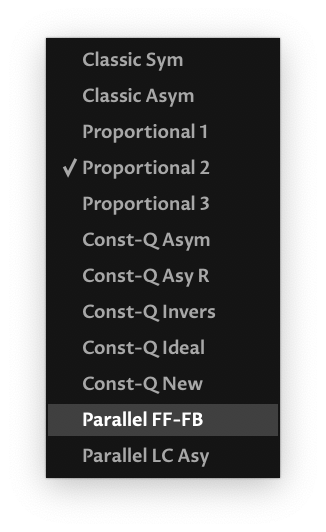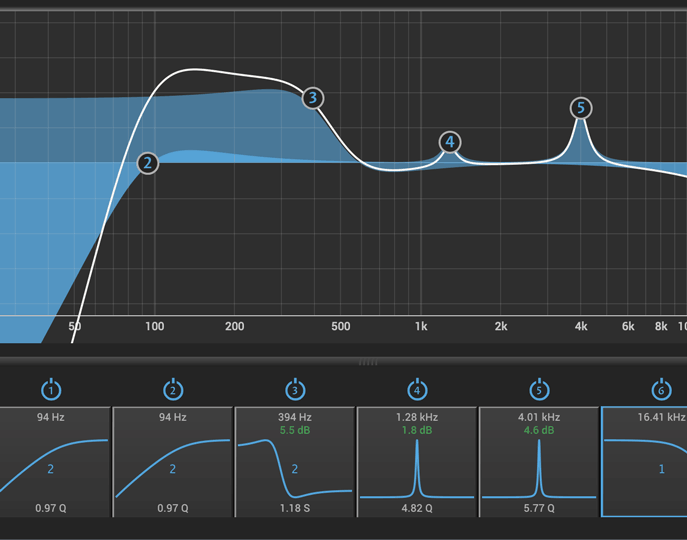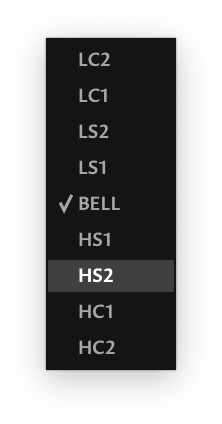Buy SantaCruzEQ12, get a free gift with purchase:
SantaCruzEQ12
12 precision variations on “analog,” all in one affordable EQ.
Beautiful analog Architectures, up to twelve, that will ramp up your reputation.
Yes, Your Blueness
Why develop yet one more minimum phase parametric equalizer (PEQ) when there’s already hundreds on the market? The answer is simple…’ Cuz there was room for improvement! It was customers of the original LinearPhase PEQ Red and Orange who asked Algorithmix to develop a classic EQ, for recording and mixing tasks, with unparalleled purity and transparency. Over several years, our Dr Christoph closely analyzed many of the best out there and compiled a vast knowledge base of analogue EQ best practices. Cherry-picking from that, he implemented not just one or two, but an entire collection of trad minimal phase EQs. The result? A distillation of analogue antecedents, while others are based on new ideas. MAAT know you’ll enjoy their dozen variations of blue, and find your favourite sound.
The Not So Dirty Dozen
MAAT wanted to lift analogue to another level, so they reverse-engineered a variety of well-respected hardware EQs, creating idealized digital versions from that inspiration. Rather than models or simulations that carry analogue baggage, SantaCruzEQ has no noise, distortion or other secondary effects inherited from analogue.
SantaCruzEQ12 is the most complete collection of classic equalizer architectures ever assembled into one package. You get precise, idealized examples of legendary analogue equalizer circuitry, complemented by progressive new models. Whether it’s vintage, modern, or experimental, SantaCruzEQ is a sonic sandbox for every mixing and mastering engineer to mess around in.
BFF
The equalizer is perhaps the oldest and the most popular of sound processing tools. From its earliest days, the main function was correction or enhancement by boosting or cutting certain frequencies.
For a century, engineers have developed countless equalizers. A few became legends, our thEQorange is one. The most popular version in recording and post is the parametric equalizer or PEQ, first perfected by Massenburg in 1972. It offers maximum flexibility with only three controls. Properly used, the PEQ is a powerful tool and the best friend of every audio engineer in the quest for the perfect sound. As Spidey (and Voltaire) always reminds us though, “With great power comes great responsibility.” When designed by a clueless or cost-constrained software engineer, it can be your greatest sonic enemy.
Choice Is Good
In order to give you a choice of features and price, SantaCruzEQ is available in two versions:
SantaCruzEQ12, with 12 architectures; all twelve below:
- Classic Sym Series symmetrical, almost constant Q bell — common mix desk & outboard gear topology, try on “surgical” applications
- Classic Asym Series asymmetrical — Old Skool, boost like № 1 but with a narrower cut
- Proportional 1 Series proportional — More musical than constant Q, especially for mixing and post. Bells are wider at <6dB and narrower at >6dB
- Proportional 2 Series proportional — Like 03 but with bigger changes at large gain settings > ±6dB, try on vocals
- Proportional 3 Series proportional — Like 03 but with extra-wide bells at small gain settings, from 0 to 3dB
- Const-Q Asym Series asymmetrical, constant Q — Boost like № 1, cut like № 5 (extra wide), as found in some USA products & mixers
- Const-Q Asy R Series asymmetrical, constant Q — Like № 6 but with mirrored boost & cut
- Const-Q Invers Series symmetrical, constant Q — Similar to № 7
- Const-Q New Series proportional, constant Q — Our special topology…try it!
- Const-Q Ideal Series ideal & constant Q — Another special, similar to № 1, all three parameters (resonant ƒ, gain & Q) are independent, with no analogue relatives!
- Parallel FF-FB Parallel feedforward/feedback — Complimentary amplitude and phase characteristics for boost & cut (symmetrical), found in high-end graphic EQs, 1st choice for mastering [reference Massenburg]
- Parallel LC Parallel passive LC — Tonal advantages with band interaction & asymmetry disadvantages, found in old or newly recreated PEQs, another choice for mastering [reference Massive Passive, Sontec]
Constant Q is more for surgical applications, while proportional EQs are best when combining multiple overlapping Sections. As a point of reference, API, Pultec, Masselec and Avalon EQs are all of the proportional type. Note that all 12 topologies are normalized to have exactly the same bell shape at 6dB of boost. This allows you to easily compare the sound of each architecture.
Note: All 12 Architectures are normalized to have exactly the same bell shape at 6dB of boost. This allows you to easily compare the sound of each Architecture.
Better By Design
SantaCruzEQ is built on the belief that exceptional fidelity, enhanced workflows and less visual fatigue are hallmarks of better quality toolsets. Our reliance on hard science and focused research balanced by in-depth listening and customer feedback redefines audio tools for you and your fellow hardcore media professionals worldwide.
Features
SantaCruzEQ borrows the innovative code from both Algorithmix’s original PEQ Blue and our own thEQblue remix, wrapping it in a modern, higher fidelity environment designed to help you be more productive.
- The most complete collection of classic analogue equalizer emulations
- Twelve different equalizer types; in total, 10 serial & 2 parallel
- Up to 12 PEQ styles for every job: classic, vintage, modern and unconventional
- Different Q characteristics: classic, constant–Q, proportional, ideal–Q and special
- True high-resolution emulation of analogue equalizers, not modelling: no added noise, distortion or other non–linearities
- Support for up to 384 kHz sample rate, suitable for HRA and game production and post
- Extended centre frequency up to 80 kHz for filtering and correction in the ultrasonic
- Bell filters in all PEQ types are normalized to look identically at +6.02 dB of gain and Q of 0.71, ideal for quick comparisons between types
- Six Sections total, with four having freely assignable parametric filter variants: bell; multi-order high & low shelf; multi-order high & low cut
- “Outer” Sections, the first and last, offer multi-order high & low shelf and multi-order high & low cut
- Extremely low noise and low nonlinear distortion algorithms result in residual THD+N significantly lower than 24-bit quantization noise
- Adjustable Q Factor for bell filters
- Adjustable slope for shelving and cut filters
- Multiple low and high cut filters can be overlapped to achieve brickwall slopes
- Very low noise and distortion upsampling for analogue–like filters at baseband sample rates
- Insane 80 bit double precision internals virtually eliminate rounding errors and resulting distortion
- Resizable and zoomable frequency response graphing for precise adjustments
- Parameter editing via numerical fields or directly on the Graph
- Presets for quick setup comparison
- Several instances, each with different PEQ architectures, can be opened simultaneously
- Band grouping function lets you simultaneously alter ƒ, Q and gain for multiple Sections
- ƒ lock function when you’ve found your resonant frequency and want to alter just Q or gain
- True Peak metering alerts you to TP overs
- Sort button rearranges Sections in order, from low to high ƒ, with a single click
Applications
With a very wide range of choices, you are ready to tackle any job with a subtle or obvious approach.
- Tracking, mixing & mastering
- HRA post including ultrasonic tailoring
- Broadcast production & post
- Game production
- Reinforcement: microphone response improvement, speaker deficiencies correction, acoustic compensation
- Sound design & enhancement
- Restoration & correction of transmission losses
Iron Maiden
The contribution of distortion to the specific sound of a particular analogue equalizer caused by its respective electronics is largely what makes it “good.” Usually though, non–linear distortion, horrific group delay and other deficiencies produce more “nasty” than “magic.” Our philosophy, for PEQ design, has always been to make filters as precise and clean as possible. For controlled distortion, MAAT recommend high-quality tape emulation, a well-made pedal or other carefully applied studio magic.
Comprehensive
With SantaCruzEQ12, you can call up twelve Sections from one of the twelve architectures available. For the first and last Sections, choose from a selection of shelving or cut filters. For the ten centre Sections, choose from nine freely assignable filter types, including bell, first and second-order low or high shelf along with first and second-order low or high cut.
The most significant filter types bearing the equalizer name are bells. Set to a particular Q, different bells change their bandwidth depending on the amount of boost or cut making comparison difficult between architectures. But wait, MAAT has made it easy…
Comparing Architectures…
In order to make meaningful comparisons of different styles, all twelve equalizer Architectures are normalized to have exactly the same bell shape for +6dB of gain. If you listen to a bell filter at +6.02dB and a Q of 0.71, you will get the same audible result for all Architecture types. This normalization of the Q or Quality Factor is a unique MAAT feature and distinguishes our Architectures from their analog antecedents because many of the originals have undefined Q definitions due to the limitation of analog technology. The normalization allows you to compare the different EQ Architectures in SantaCruzEQ with ease.
BTW, a single minimal phase bell filter with identical shape will sound the same regardless of Architecture. The difference between Architecture becomes obvious when you have activated more bells and other topologies so that they start to interact with each other. This will reveal the different characteristics of each Architecture, in terms of phase interaction and different gain and Q relationships.
Classics All
The Classic Symmetrical is the most popular bell shape used in many mixers and outboard equalizers. It is almost “constant Q.” That is, as resonant frequency changes, the bandwidth changes, widening as the frequency goes from low to high to maintain a constant ratio of centre frequency divided by bandwidth. Constant Q is roughly the way our hearing perceives an EQ’s effect.
The three Proportional PEQs emulate bell characteristics which change their bandwidth proportional to their boost or cut. Many think they behave more musically as you don’t have to correct the Q after every amplitude change. There are also three other constant–Q equalizers available, with characteristics similar to some classic American brands.
SantaCruzEQ also offers two proprietary constant–Q varieties. The first, Constant-Q Ideal, is a perfect version of the Classic Symmetrical equalizer, having exactly the same bandwidth at any amplitude within its range of Q. This is measured 3 dB below maximum amplitude at and above +6 dB of boost. Such PEQs are impossible to implement in the analogue domain, hence the “ideal” name. Another speciality variety is the Constant-Q New, which follows a new Q definition. It preserves exactly the same bandwidth at half of the maximum amplitude for all amplitude values. Unlike the classic Q definition, this includes the range below 6 dB of boost. Due to its amplitude/bandwidth dependency in terms of a classic Q definition, this new kind of constant-Q PEQ could also be thought of as a member of the proportional group.
Finally, MAAT emulated two vintage parallel equalizers. With parallel construction, the main input feeds every filter in parallel, with each filter’s output being summed together for the final composite output. With a series implementation, filters are cascaded; each fed from the output of the previous filter. Unlike a series parametric equalizer (almost all parameters are serial), parallel–connected filters combine or cascade differently. They also behave differently in terms of phase. Their special interactive behaviour between bands is offset by a pleasing sonic character. Our Parallel LC emulates old skool parallel passive PEQ circuitry built with inductors and capacitors. The Parallel Feed-Forward/Feedback topology emulates the feed-forward/feedback designs still popular in low noise analogue graphic EQs. While the feed-forward path is trivial to implement, the feedback path is impossible to implement in traditional digital signal processing, because of the need for so-called “delay–free” feedback loops. In SantaCruzEQ, MAAT applies a unique and very elaborate technique for true emulation of delay-free feedback. The result is a characteristic sound and perfectly complementary filters for boost and cut.
The Filter Library
In SantaCruzEQ, not only are various bell-shaped filters available but also different kinds of shelving filters. Nine of the series equalizers use a special shelving design characterized by a cut–off frequency defined in the middle of the transition region. MAAT found these filter definitions more intuitive than the classical “–3 dB below maximum.” The old skool definition is only used in the Classic Asymmetrical architecture in order to conform to its analogue antecedent. All 2nd order shelving filters have a Q adjustment to emulate vintage characteristics, with their inherent and specific bumps at higher slopes. Also, the parallel equalizers are equipped with respective shelving filters shapes that are typical of old parallel PEQs. They also have interacting bands as did their analogue predecessors.
Every complex PEQ is equipped with cut filters. With SantaCruzEQ, each of the twelve equalizer topologies can provide 1st and 2nd order cuts. The 2nd order filters have a Q adjustment to create a resonant filter response and can be combined to provide very steep “brickwall” slopes by cascading several Sections.
Best of Both Worlds
SantaCruzEQ is a creative equalizer tool combining the best of both the analogue and digital domains. To avoid bell filter asymmetry at high frequencies for baseband sample rates, typical of many digital equalizers, MAAT have applied reference-quality upsampling, which automatically kicks in for 44.1 or 48 kHz. By using proprietary filter algorithms, they have achieved a huge dynamic range, as well as extremely low noise and distortion. This yields unparalleled sonic purity, impossible for any analogue circuitry. MAAT suggest leaving the oversampling option always on so as to get the “analogue” smoothness missing from other brand’s EQs.
Summary
- Fully parametric minimum phase EQ for complete control
- 80-bit internal precision blows away the competition for sound quality
- Up to twelve unique idealized Architectures, derived from analog circuitry
- Broad choice of cut, shelf and bell topologies
- AutoGain for effortless A/B comparisons
- Proprietary oversampling for “analog” sound at 44.1 and 48k
System Requirements
Operating Systems
- macOS 10.9 or newer (64-bit only)
Windows 7 and newer (32 & 64-bit)
Supported Platforms
- AAX (Pro Tools 10.3.10 and newer)
- AU, VST 2, VST 3
- Sample rates from 44.1 to 384 kHz
Note: DRMeter MkII is used as the example
Mac Installation
1. Download the .zip folder from your Plugin Boutique User Account and double-click it's contents.
2. Double-click the .dmg installer file to begin the installation process > Click 'Continue'.
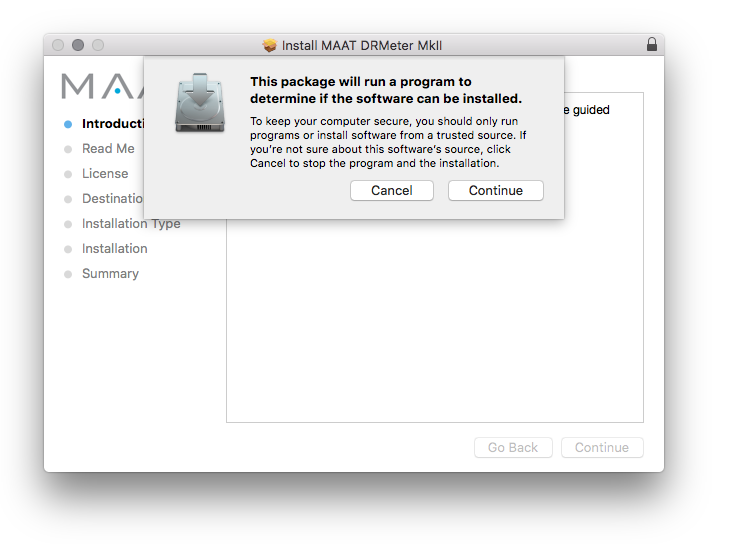
3. Enter your name and Email > Click 'Register'.
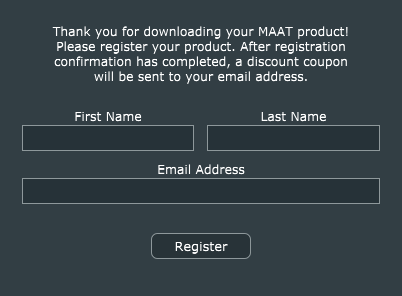
4. Click 'Continue'.
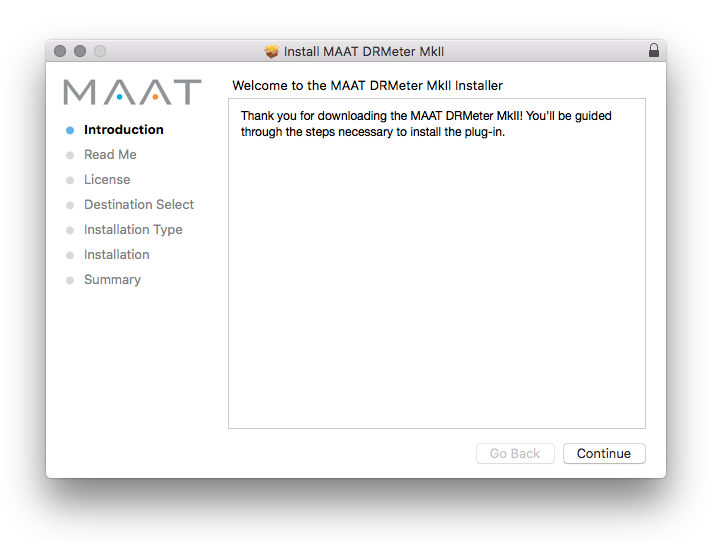
5. Click 'Continue'.
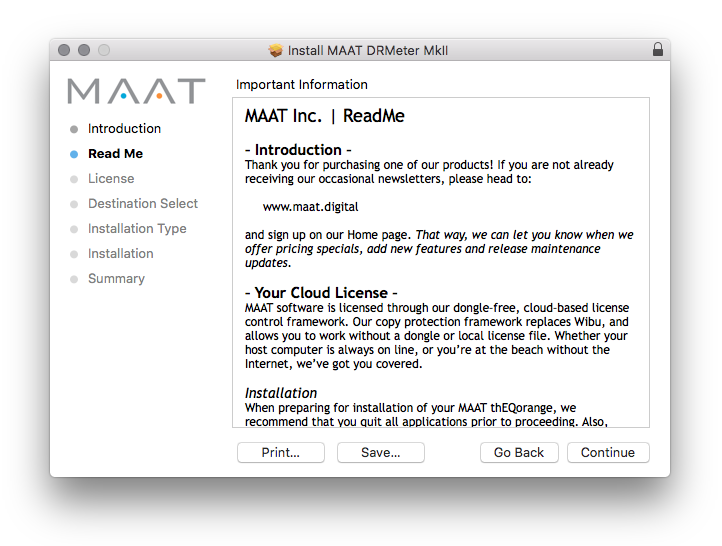
6. Click 'Continue'.
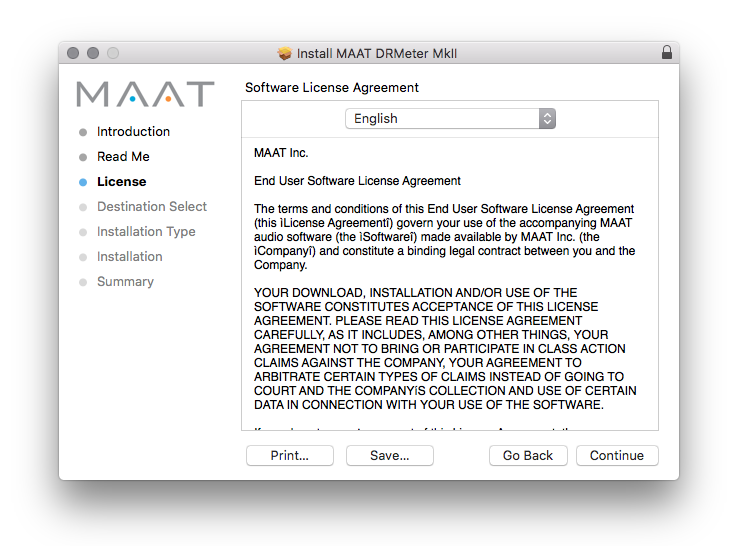
7. Click 'Agree'.
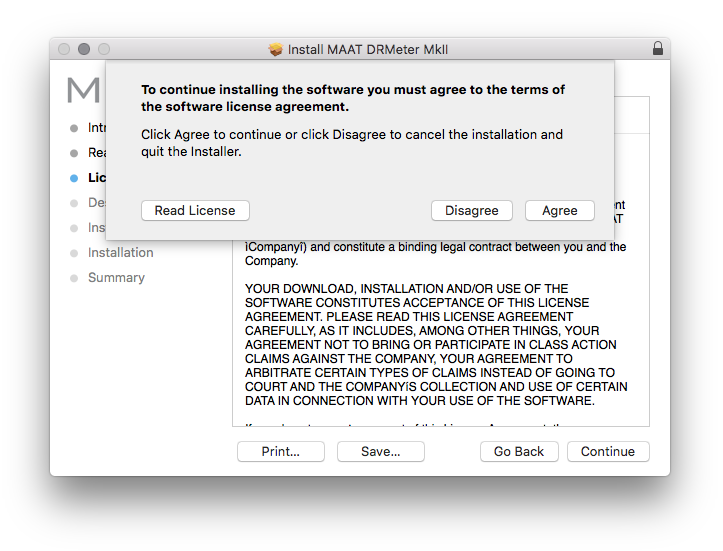
8. Click 'Continue'.
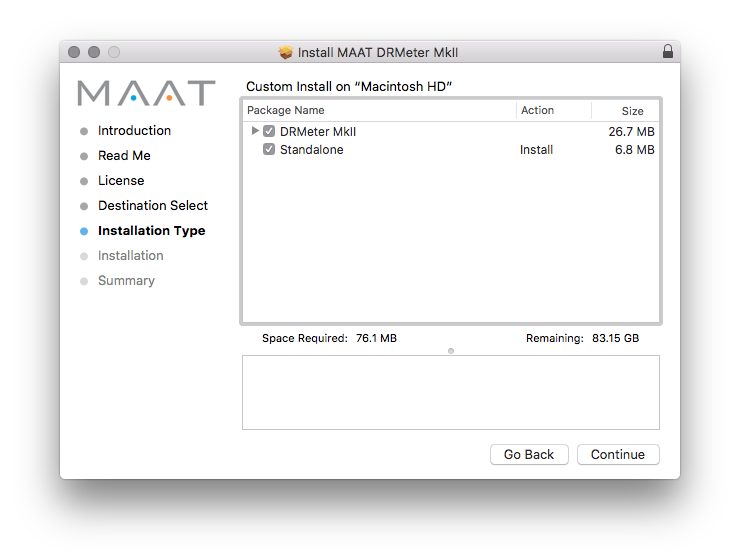
9. Click 'Install'.
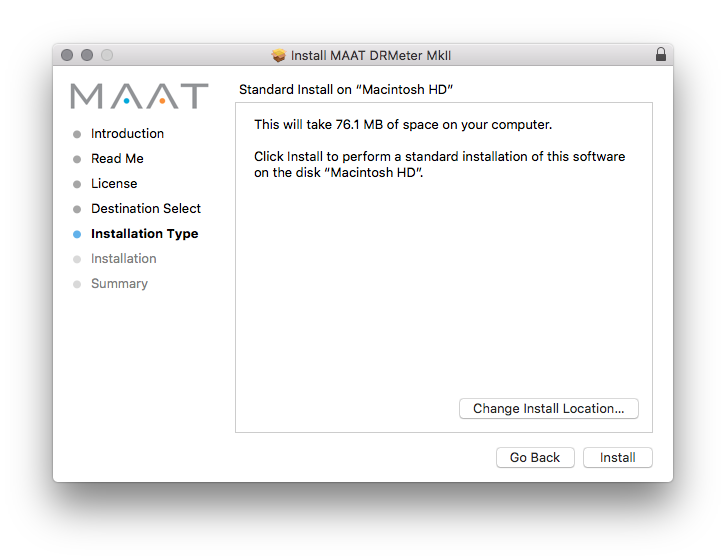
10. Click 'Close'.
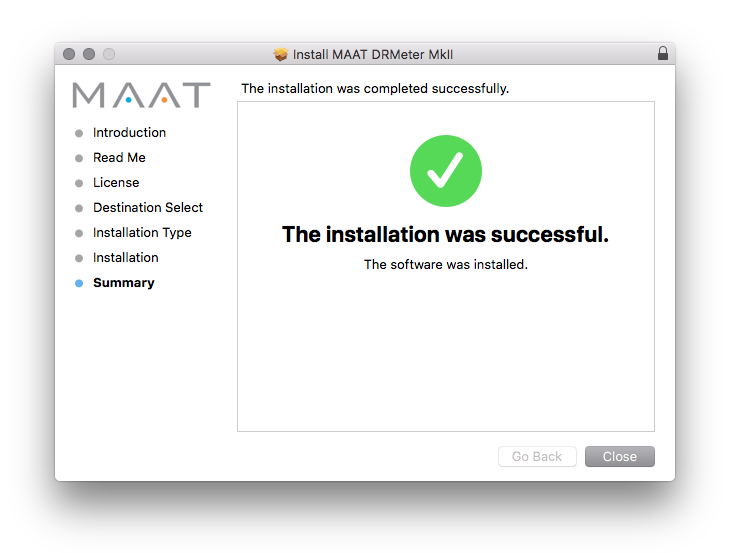
Mac Online Activation
1. Open MAAT DRMeter MKII as a standalone or inside of your DAW. > Click 'Activate/Deactivate License'.

2. Enter the Product Key that can be found in your Plugin Boutique User Account > Click 'Activate Online'.

3. Click 'Ok'.

Your software has now been activated and is ready for use!

Mac Offline Activation
1. Open MAAT DRMeter MKII as a standalone or inside of your DAW. > Click 'Activate/Deactivate License'.

2. Enter the Product Key that can be found in your Plugin Boutique User Account > Click 'Create License Request'.

3. Click 'OK'.

4. Choose a location for the License Request File to be saved > Click 'Open'.
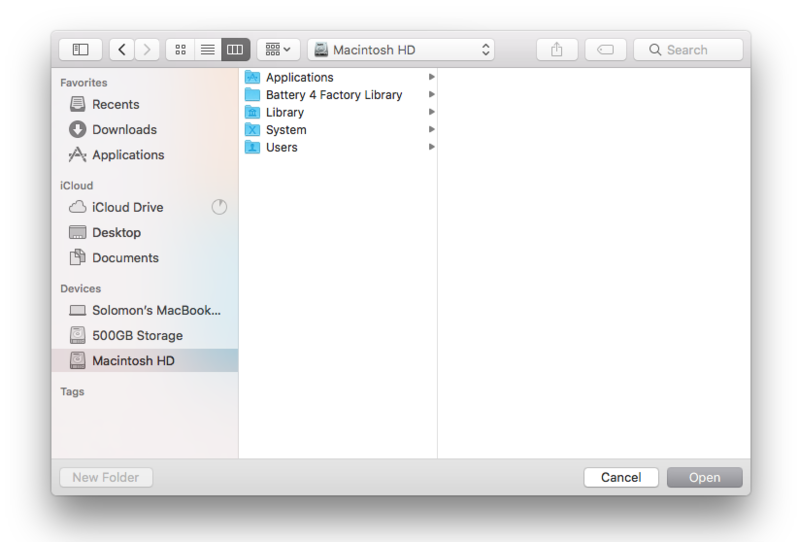
5. Email the License Request File to support@maat.digital
6. Once you have received the .maatc confirmation file from MAAT open MAAT DRMeter MKII > Click 'Activate/Deactivate License'.

2. Click 'Activate Offline'.

3. Click 'OK'.
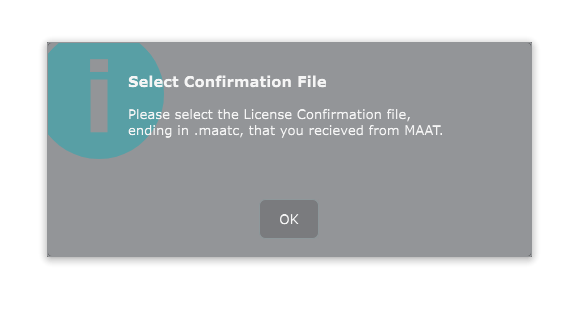
4. Find the .maatc confirmation file sent from MAAT > Click 'Open'.
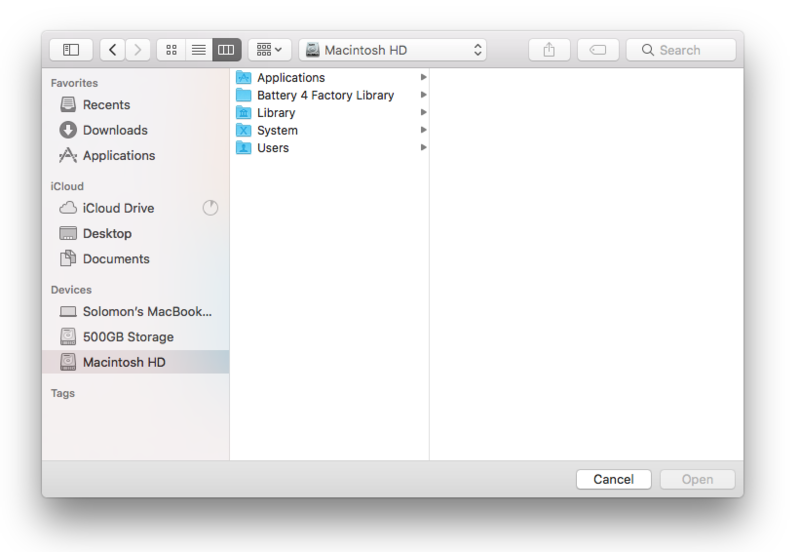
5. Click 'Ok'.
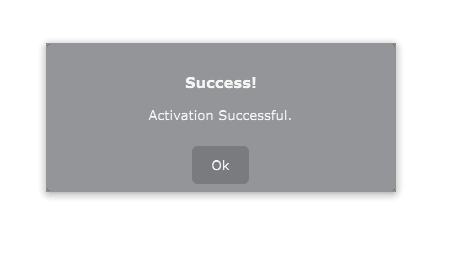
Your software has now been activated and is ready for use!

Windows Installation
1. Download the .zip folder from your Plugin Boutique User Account and double-click it's contents.
2. Double-click the .exe installer file to begin the installation process.
3. Enter your name and Email > Click 'Register'.

4. Select 'I accept the agreement' > Click 'Next'.
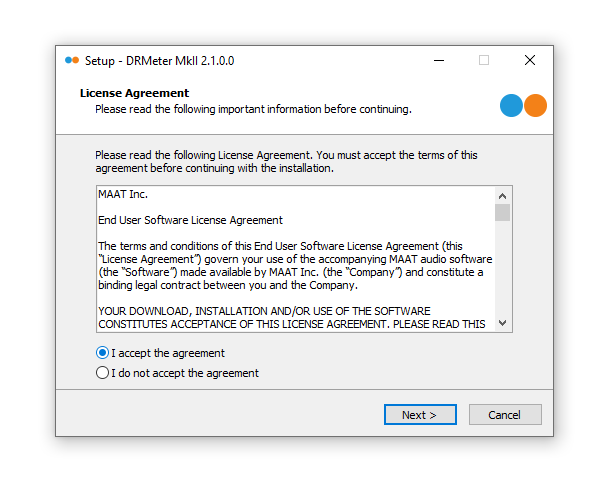
5. Click 'Next'.
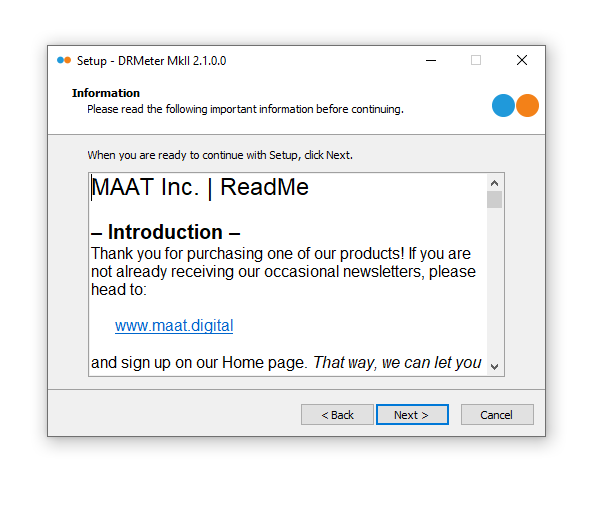
6. Click 'Next'.

7. Click 'Next'.
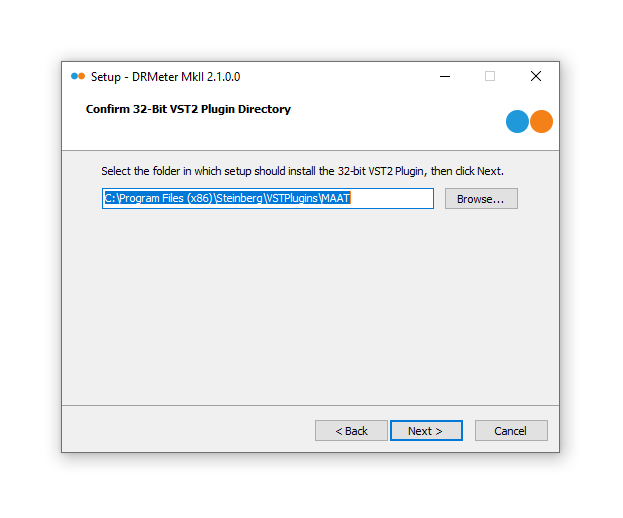
8. Click 'Next'.
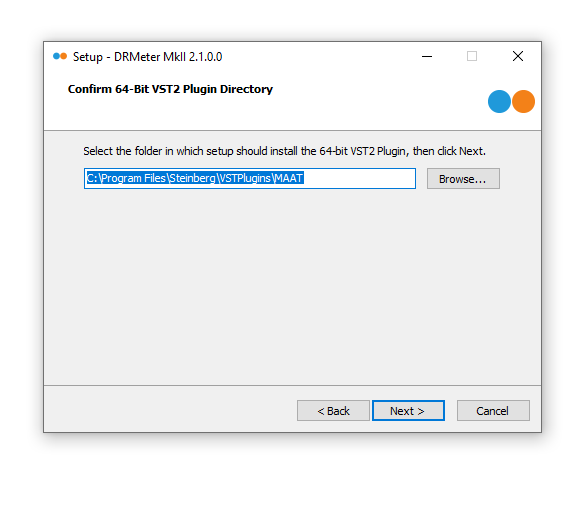
9. Select the components you would like to install > Click 'Next'.
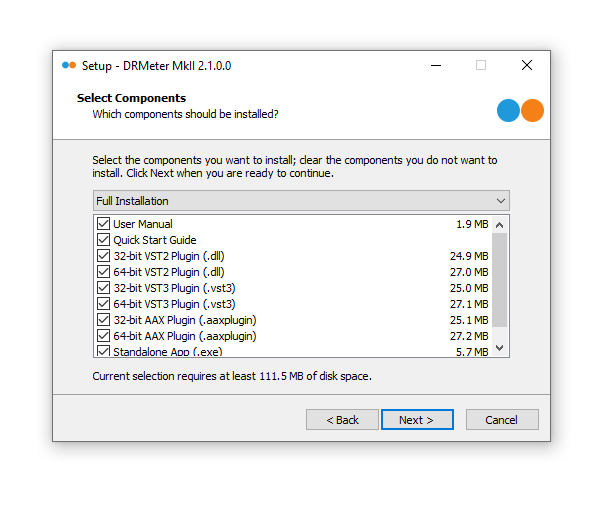
10. Click 'Install'.
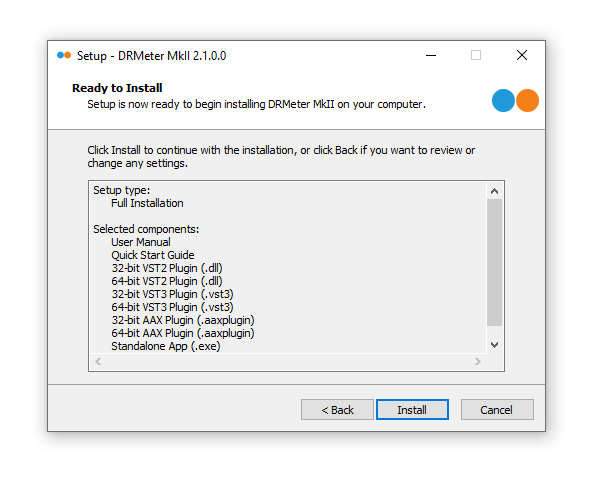
11. Click 'Finish'.
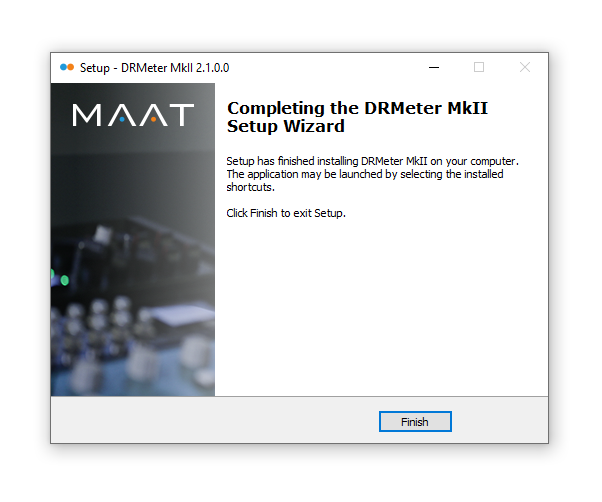
Windows Online Activation
1. Open MAAT DRMeter MKII as a standalone or inside of your DAW. > Click 'Activate/Deactivate License'.

2. Enter the Product Key that can be found in your Plugin Boutique User Account > Click 'Activate Online'.

3. Click 'Ok'.

Your software has now been activated and is ready for use!

Windows Offline Activation
1. Open MAAT DRMeter MKII as a standalone or inside of your DAW. > Click 'Activate/Deactivate License'.

2. Enter the Product Key that can be found in your Plugin Boutique User Account > Click 'Create License Request'.

3. Click 'OK'.

4. Choose a location for the License Request File to be saved > Click 'OK'.
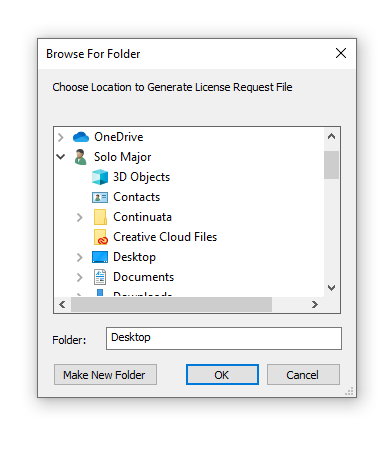
5. Click 'OK' and email the License Request File to support@maat.digital
6. Once you have received the .maatc confirmation file, open MAAT DRMeter MKII > Click 'Activate/Deactivate License'.

2. Click 'Activate Offline'.

3. Click 'OK'.

4. Find the .maatc confirmation file sent from MAAT > Click 'Open'.
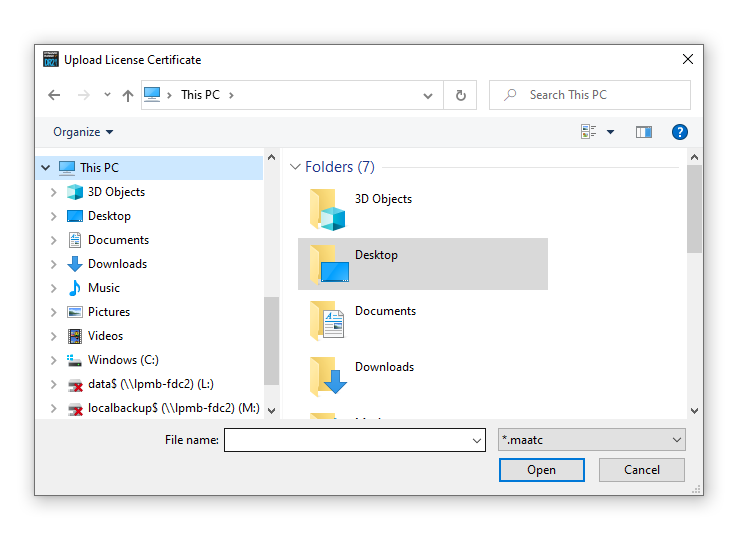
5. Click 'Ok'.

Your software has now been activated and is ready for use!

